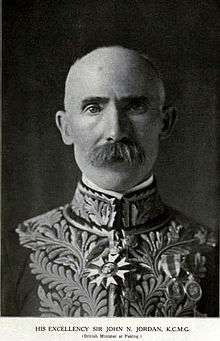John Jordan (diplomat)
| The Right Honourable Sir John Newell Jordan GCMG GCIE KCB | |
|---|---|
 | |
| Envoy Extraordinary and Minister Plenipotentiary from the United Kingdom to the Qing Empire | |
|
In office 19 September 1906 – 12 March 1910 | |
| Monarch | Edward VII |
| Preceded by | R.G. Townley |
| Succeeded by | William Grenfell Max-Muller |
| Envoy Extraordinary and Minister Plenipotentiary from the United Kingdom to the Republic of China | |
|
In office 28 November 1910 – 1 March 1920 | |
| Monarch | George V |
| Preceded by | William Grenfell Max-Muller |
| Succeeded by | Sir Beilby Alston |
| Personal details | |
| Born |
5 September 1852 Balloo, County Down, Ireland, United Kingdom |
| Died | 14 September 1925 (aged 73) |
| Alma mater |
Royal Belfast Academical Institution Queen's College, Belfast Queen's College, Cork |
Sir John Newell Jordan GCMG GCIE KCB PC (5 September 1852 – 14 September 1925) was a British diplomat.
Life and career
Jordan was born in Balloo, County Down, Ireland, the son of a wealthy Presbyterian farmer. He apparently never lost his Irish accent. He was educated at the Royal Belfast Academical Institution, Queen's College, Belfast[1] and Queen's College, Cork. In 1876 he joined the Chinese Consular Service as a student interpreter. He held various posts in South China before being appointed Chinese Secretary at the British Legation in Peking in 1891. In 1896 he was appointed Consul-General at Seoul, Korea, becoming Chargé d'affaires in 1898 and Minister-Resident in August 1901.[2] He remained there until November 1905, being appointed Knight Commander of the Order of St Michael and St George (KCMG) in 1904. Jordan received the Queen Victoria Jubilee Medal in 1897 followed by the King Edward VII Coronation Medal in 1902.[1]
In 1906 he was appointed HM Envoy Extraordinary and Minister Plenipotentiary to China as the successor to Sir Ernest Satow[3][4] and remained in the post until his retirement in 1920. He was appointed Knight Commander of the Order of the Bath (KCB) in the 1909 Birthday Honours and in 1910 received the Freedom of the City of Belfast at the same ceremony as the Scottish-American industrialist Andrew Carnegie.[5] Jordan was appointed Knight Grand Commander of the Order of the Indian Empire (GCIE) in 1911, and Knight Grand Cross of the Order of St Michael and St George (GCMG) in the 1920 Birthday Honours shortly after his retirement. He was also appointed to the Privy Council in 1915, entitling him to the style "The Right Honourable". In 1920, Jordan became a director of the Chartered Bank of India, Australia and China.[6]
Jordan, despite his retirement, was a delegate to the Washington Naval Conference of 1921–1922.
Legacy
At his death he left estate valued at £39,409.[A][7]
Jordan Road in Hong Kong's Kowloon District is named after him.[8]
Notes
Footnotes
- 1 2 "Privy Councillors". Daily Record. British Newspaper Archive. 3 June 1915. Retrieved 4 August 2014. (subscription required (help)).
- ↑ The London Gazette: no. 27344. p. 5256. 9 August 1901.
- ↑ Robert Hart; James Duncan Campbell (1975). The I. G. in Peking: Letters of Robert Hart, Chinese Maritime Customs, 1868-1907. Harvard University Press. p. 1419. ISBN 978-0-674-44320-4.
- ↑ "[Untitled]". Manchester Courier and Lancashire General Advertiser. British Newspaper Archive. 27 November 1920. Retrieved 24 July 2014. (subscription required (help)).
- ↑ "Mr. Carnegie Will Receive Freedom of Belfast". Evening Telegraph (Dundee). British Newspaper Archive. 26 September 1910. Retrieved 4 August 2014. (subscription required (help)).
- ↑ "Announcement". Aberdeen Journal. British Newspaper Archive. 27 November 1920. Retrieved 24 July 2014. (subscription required (help)).
- ↑ "Recent Wills". Aberdeen Journal. British Newspaper Archive. 6 November 1925. Retrieved 4 August 2014. (subscription required (help)).
- ↑ Jason Wordie. Streets: Exploring Kowloon. Hong Kong University Press. pp. 60–61. ISBN 9789622098138.
- ↑ MeasuringWorth.com
References
- Biography, Oxford Dictionary of National Biography